You don’t need an office to start something real. In fact, half of all U.S. small businesses begin at home. And with the right steps, yours can too. This guide covers how to set up a home-based business that’s legit, focused, and built to grow - all starting from exactly where you are.
Why should you set up a small business at home?
If you're thinking about starting a small business, starting from home is often the smartest and most realistic move. It’s cost-effective, flexible, and built for how people actually work in 2025. For solopreneurs, side hustlers, and full-time founders alike, home is more than enough to get serious work done. Here's why:
It’s more affordable than you think
Most home-based businesses launch with less than $5,000. Skip office leases, furniture budgets, and extra utility bills — your home is already set up. Want quick proof?
Compare this:
- Office lease (small shared office): $500/month
- Utilities, internet, insurance: $150/month
- Office furniture & setup: $1,000 upfront
vs. home setup:
- Desk, chair, light gear: ~$350 one-time
- You already pay rent and internet.
The future is remote
By 2028, 73% of small businesses are expected to operate remotely. Customers, partners, and clients care more about your results than where you work. Home-based doesn’t mean less professional — it means more adaptable. Your setup evolves with you, not the other way around.
Flexibility is your power
Running a business from home means setting your own hours, designing your own space, and balancing your life with your work. That flexibility is compelling for parents, caregivers, or anyone with multiple roles to juggle.
You don’t need an office to look — or act — legit
Office space doesn’t automatically equal credibility. Today, most clients don’t expect a physical storefront, they just want clear communication, good service, and timely delivery.
With the right digital tools and setup, your home-based business can run as smoothly (or smoother) than a traditional one, all without the commercial lease.
How to set up a small business at home: step-by-step
Step 1: Identify a home-compatible business idea
Not every business works well from home, but plenty do. The key is picking something that suits your skills, fits your space, and doesn’t require a full warehouse or customer foot traffic.
- Virtual assistance suits highly organized people — think inbox cleanup, appointment scheduling, or light project management.
- Handmade crafts work if you’re creative and detail-oriented, and you’ve got the space to store materials or finished products.
- Freelance writing is a solid option if you’re a strong communicator and enjoy research. Writers are always in demand for blogs, websites, and newsletters.
- Online tutoring is ideal if you’re patient, good at explaining things, and have subject-matter expertise in math, languages, or test prep.
It doesn’t have to be all-or-nothing. A home-based business can start small, even as a side gig alongside your job. Once you test the waters and build momentum, you can grow at your own pace.
One standout example is Artemis Design Co., founded by Milicent Armstrong. She began crafting shoes using Turkish textiles and invited early customers into her Boston apartment to try them on. That personal, home-based experience helped her build a loyal following, long before she had a storefront.

It’s proof that even product-based businesses can thrive from a living room, when the offer and audience align.
Where to find a business idea?
Need inspiration? Read our blog post or start here:
Check local job boards like Craigslist
Sites like Craigslist are full of listings of businesses asking for quick and immediate help, and many of these tasks can be done from home. For example, in New York alone, you’ll find requests for virtual assistants, creative marketers, and remote brand ambassadors — often with hourly or project-based pay.
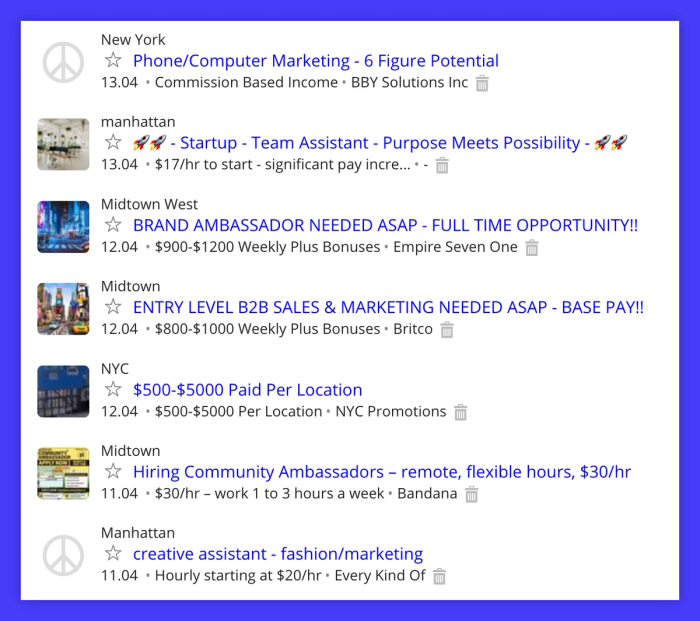
Scroll the listings, take note of what matches your skill set, and ask yourself: could I offer this as my own service?
Look at what’s trending in Facebook groups and creative communities
Social groups are a goldmine for spotting niche hobbies and finding ways to turn them into micro-businesses. Take adult coloring, for example — it’s seen a massive rise in popularity as a relaxing, screen-free activity. In one post alone, a simple shading tip sparked dozens of comments and over 100 reactions.

This kind of engagement is a strong signal that people are interested in this topic. If you enjoy drawing or design, there’s real potential to turn your skills into printable coloring books or digital downloads people love to buy and share.
Ask your network what they’d happily outsource
Sometimes, the best business ideas are hiding in plain sight. Ask people you trust what kinds of tasks stress them out or eat up their time — the answers often point directly to services you could offer from home. Think admin help, tech support, or anything repetitive that they’d gladly delegate.
Step 2: Conduct market research from home
Now that you’ve picked an idea, it’s time to make sure there’s demand for it — and that you understand who you’re trying to reach.
Market research might sound big and technical, but at this stage, it’s just about gathering smart, scrappy insights before you go all in.
Where to validate your business idea?
Start with tools that cost nothing:
- Google Trends shows what people are searching for (and how interest shifts over time).
- AnswerThePublic helps you discover common questions people ask about your topic.
- Reddit and Facebook groups reveal what your future customers complain about or wish existed. They will tell you everything — if you listen. Just search something like 'phone cases' on Reddit and you’ll find gold: posts asking where to buy cute ones, why Android options are so limited, and which brands are actually worth the money.
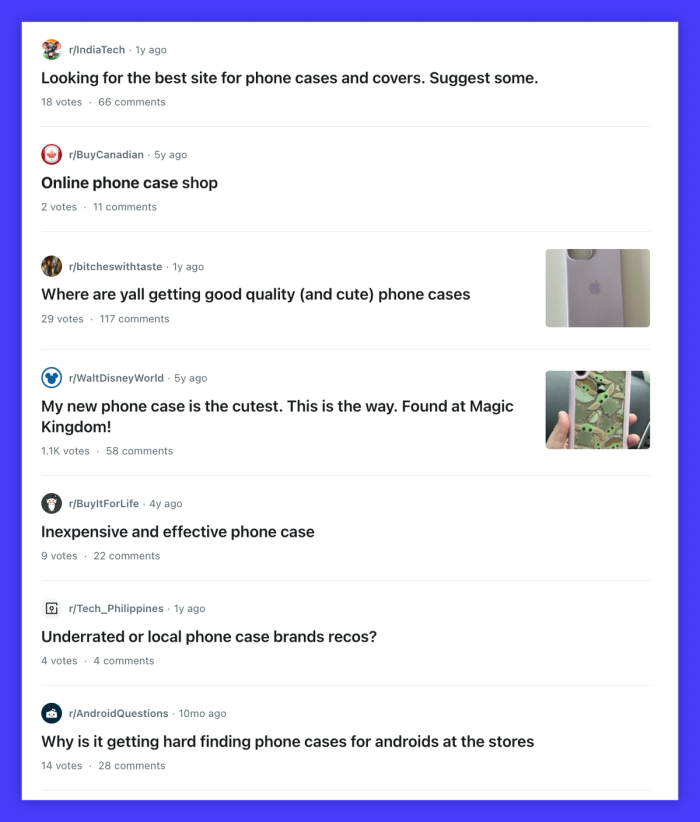
Look at the language people use ('cute but protective,' 'underrated brands,' 'can’t find them anywhere') — that’s what your product copy and positioning should reflect. It’s free, it’s honest, and it’s all right there.
- Etsy and Amazon reviews show what buyers love — and what’s missing — in your niche.
- You can even post a simple poll on Instagram or LinkedIn to get quick feedback.
How to find your target audience?
To identify your target audience, start by asking: Who actually needs this? Who would pay for it? Think beyond age or location — focus on behaviors and motivations. Are you helping busy parents save time? Supporting artists with better tools? Making someone’s day easier, more fun, or more efficient? Many small business owners skip these questions, and that's a huge mistake.
Once you have a rough idea, dig deeper:
- Check where these people spend time online. Are they asking for advice on TikTok? Following niche influencers on Instagram? Active in Reddit threads?
- Read how they describe their struggles. Look for repeated phrases or patterns — those are pain points you can speak to in your messaging.
- Check what gets their attention. Are they deals, trust signals, or personal stories? These insights will come in handy once you start marketing.
How to track competitors?
For competitor research, you don’t need fancy tools or big budgets — just a curious eye. Search for others offering similar services or products, ideally ones run by solo founders or small teams.
Start with their:
- Website – What’s their pitch? What problems are they solving?
- Pricing �– How do they charge, and what’s included?
- Customer reviews – What do people praise or complain about?
- Social media – What content gets traction? What tone do they use? You should also check the hashtags they're using, for example, #HomeBasedBusiness or #EtsyStudio
Competitor insight can be as simple as reading a TripAdvisor review.
Let’s say you’re starting a local tour business. Before building anything, check what people are already saying about similar services in your area. From the image below, it’s clear that customers value two things: knowledgeable guides and flexible times to explore.
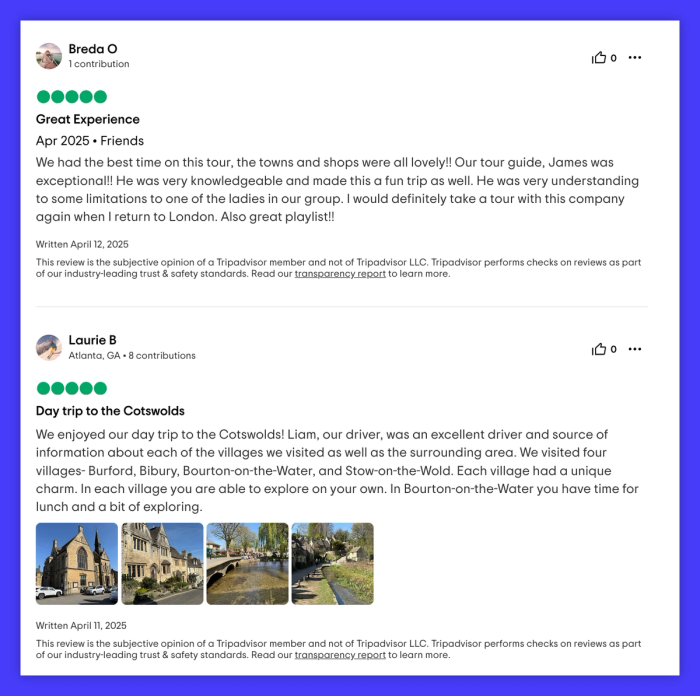
That tells you exactly what to highlight on your own website — and what to be sure to deliver. Reviews are more than praise; they’re a cheat sheet for what works.
Your goal isn’t to copy — it’s to spot gaps, patterns, and opportunities to do something better, simpler, or more aligned with your voice.
Step 3: Develop a simplified business plan
Even home businesses need a plan of action — not a 40-page report, but a clear roadmap. A detailed business plan helps you stay focused, prioritize your next steps, and avoid costly surprises later.
At a minimum, your plan should cover:
- Your home business idea – What are you offering, and why now?
- Business goals – What does success look like in 3, 6, or 12 months?
- Target market – Who are you selling to, and what problem are you solving?
- Marketing plan – How will you reach people? Think social media, local groups, or SEO.
- Business structure – Sole proprietorship or LLC? (We’ll cover this more in Step 4.)
- Financial projections – What will it cost to start, and how much do you expect to earn?
To help, we’ve created a simple business action plan template made for small-scale, home-based entrepreneurs. Set milestones that feel achievable. Maybe it’s 'get my first client' or 'make $500 in one month.' A strong plan doesn’t guarantee success, but it does give new business owners a fighting chance from day one.
Step 4: Understand legal requirements and zoning laws
Even if you’re starting small, setting up your own business from home still means following a few essential rules. It’s what separates a side hustle from a serious business — and helps protect your personal assets along the way.
Start by checking local zoning laws. Some cities limit business operations in residential areas, especially for retail businesses with foot traffic or service businesses like tutoring services, cleaning services, or anything with customer visits.
If you rent or live in a managed building, review your lease or HOA agreement — they may have restrictions on things like signage, delivery volume, or setting up a dedicated office space.
Next, choose a legal structure. A sole proprietor setup is simple but offers less personal liability protection. If you want to separate your business finances or plan to hire employees, consider forming a limited liability company (LLC).
You’ll also need to:
- Register your business name with your state filing office
- Apply for a free Employer Identification Number (EIN) from the federal government
- Keep your business and personal finances apart, especially when tax season rolls around — we’ll explain how in Step 6.
- Apply for any necessary local or state licenses or permits
Getting these steps right early will make it easier to apply for small business loans, manage taxes, and grow with confidence, no matter what kind of home business idea you’re building.
Step 5: Set up a dedicated workspace
One of the biggest differences between a hobby and a successful business is how you treat your time and space. Technically, you can work from your kitchen table. But should you? We wouldn’t recommend it.
Creating a dedicated workspace isn’t just about productivity — it protects your posture, your focus, and your boundaries. Nearly 48% of people working from non-optimal spaces like sofas develop back, neck, or joint issues. That alone is a good reason to get off the couch and into a better setup.
Here’s a basic checklist:
Must-haves:
✔ A comfortable office chair with back support (example)
✔ A table or desk at the right height (example)
✔ Strong internet connection
✔ Quiet, well-lit space (natural light = bonus)
Nice-to-haves (depending on your business):
➕ Ring light for video calls or content creators (example)
➕ External microphone if you run webinars or record online courses
➕ Monitor riser or laptop stand (example)
More than anything, having a space that signals 'work mode' helps separate your business from your personal life. When your brain knows it’s time to focus, your clients will feel it too.
Step 6: Manage finances and budgeting
Budgeting isn’t fun, but it’s what keeps your home business idea running.
Compared to a brick-and-mortar business, your financial setup will likely be leaner — no storefront rent, utilities, or in-person staff to manage. But even a home business needs structure to stay profitable, organized, and ready to grow.
Start by opening a business bank account to keep personal and business finances separate.
It’s essential for clean bookkeeping, tax benefits, and filing federal taxes.
Build a simple budget that covers startup costs (like tools or branding) and ongoing expenses (like subscriptions or shipping). Use a spreadsheet or accounting software to track cash flow.
Not sure if you need a business credit card? Here's a quick comparison:
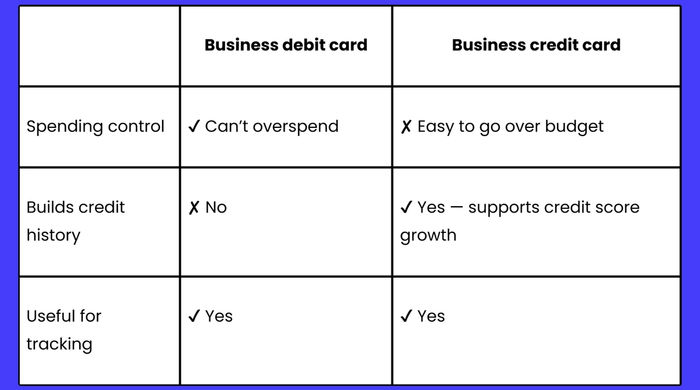
Pro tip: If you get a business credit card, pay it off in full each month to avoid interest and keep your finances healthy.
Step 7: Build an online presence
You don’t need to go viral, but make sure you’re easy to find.
In a world where people Google before they buy, your online presence is often your first — and only — chance to make a good impression. Especially when you don’t have a physical storefront, your website and social channels are how potential customers evaluate your credibility, your offer, and whether you’re the right fit.
That said, not everything needs to happen at once. Here’s how to focus your energy:
🟢 Must-haves (do these early!):
- A one-page website – Use simple builders like Carrd, or explore the top website builders for small businesses. You just need a clear message: what you do, who it’s for, and how to get in touch.
- One active social media profile – Choose the platform where your audience already hangs out. TikTok for crafters? LinkedIn for consultants? One good channel beats five silent ones.
- A professional email address (like hello@yourbiz.com) builds trust and makes you look polished from day one.
🟡 Nice-to-haves (as you grow):
- Google Business Profile – Crucial for anyone serving local customers. Helps you show up in maps and local searches.
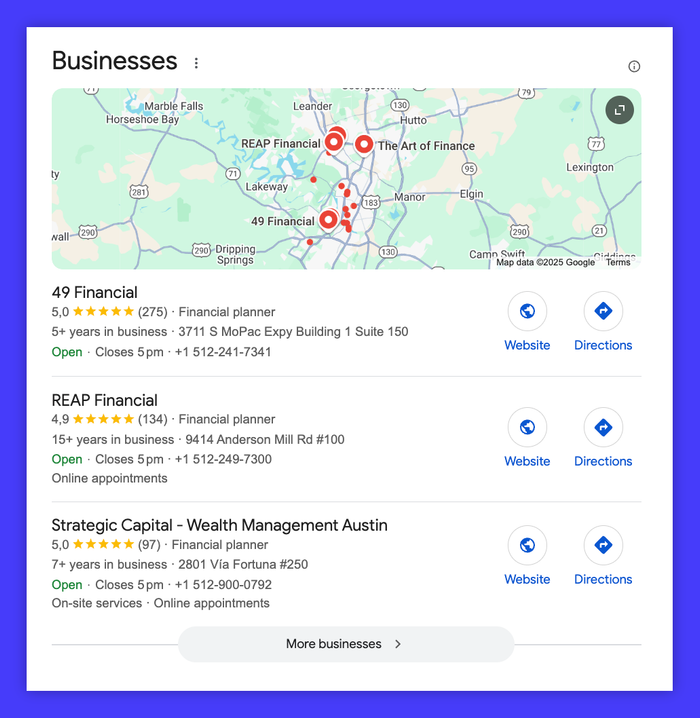
- A basic content strategy – Blogs, guides, or short-form posts build trust over time. Not sure how? Use this small business content blueprint.
- A consistent social plan – If you’re ready, you can plan your posts ahead using a simple format. Just one or two posts a week can keep your audience engaged, especially when you know what they care about.
🔴 Skippable for now (and here’s why):
- Running paid ads before you know your audience – Ads can eat up your budget fast. If you’re still figuring out who you’re targeting or what messaging resonates, it’s like throwing darts in the dark. Wait until you’ve had some real conversations with customers first.
- Building profiles on every social platform – More channels = more upkeep. Spreading yourself thin leads to half-finished pages and outdated posts, which can hurt trust more than help it. Start with one channel and show up well there.
- Spending big on branding or hiring an agency – You don’t need a custom logo or $2,000 website on day one. What you need is clarity: who you help, how, and why it matters. Fancy design can come later — solid messaging comes first.
Step 8: Implement efficient home-based operations
Running a business from home gives you flexibility, but without structure, it’s easy to lose focus or burn out.
Start with the right tools. A clear system for tracking clients, tasks, and conversations helps you stay on top of your work, without the post-it notes or scattered spreadsheets. Capsule CRM is a great companion here: you can organize contacts, manage deals, set reminders, and keep your pipeline in motion, all from one dashboard. It’s lightweight but powerful, especially for service-based businesses or solo founders wearing every hat.
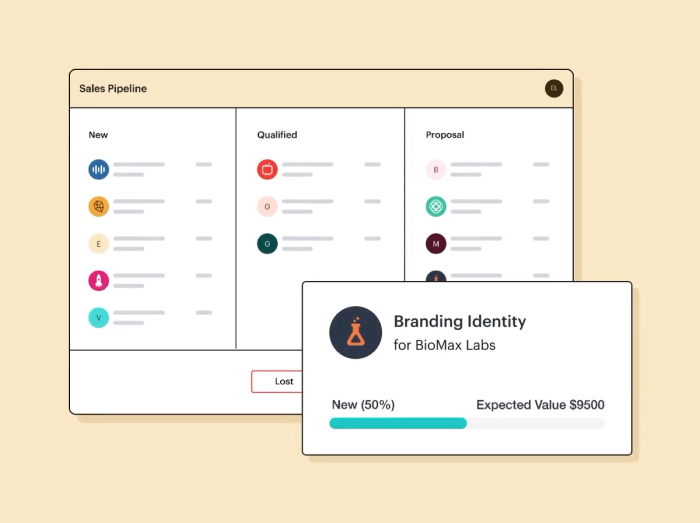
Next: time management. Working from home means you’re just steps away from laundry, distractions, or family needs — which is why it’s almost essential to pick a structure and stick with it.
- The Pomodoro technique (25-minute sprints with 5-minute breaks) helps maintain focus and rhythm
- The Eisenhower Matrix prioritizes what’s urgent vs. important — a game-changer when everything feels pressing
- Working in shifts (e.g., 9–12 and 2–5) balances deep work with home life
And the stats back this up:
💡 60% of workers using Pomodoro report handling tasks efficiently 4–5 days a week
💡 50% of Eisenhower users feel in control of their workload daily
📉 69% of remote workers report burnout symptoms due to blurred home/work boundaries
That’s why setting limits matters. Define your work hours. Close the laptop when you're 'off.' Let others in your home know when you're unavailable. The boundaries you build protect your focus and your wellbeing.
Step 9: Market your business effectively
Just because you built it doesn’t mean they’ll come.
Setting up your business is a huge step — but if no one hears about it, it stays a best-kept secret.
For home-based businesses, effective marketing is about being intentional, personal, and consistently showing up where your people are.
Start close to home. Your local network can be a powerful launchpad. One example? Three Ships Beauty — now a global skincare brand — started with just $4,000 and a kitchen setup.

source: https://www.instagram.com/threeshipsbeauty/p/DIHpOoJRmFu/?hl=en
In the beginning, the founders reached out to friends and offered referral perks like free samples and handwritten thank-you notes. That grassroots loyalty led to national retailers like Whole Foods and Target. The takeaway? You don’t need ads — you need advocates.
The Outrage, founded by Rebecca Lee Funk, took a values-first approach to marketing from the start. She ran the business from home using a print-on-demand model and focused on mission-driven storytelling around gender equality. This clear social stance helped The Outrage stand out in a crowded ecommerce space — and rally a loyal community.

It’s a reminder that marketing isn’t always about discounts or ads. Sometimes, it’s about leading with purpose.
Here’s how to market smart without overspending:
- Tap into local and niche communities. Show up in communities you already know — like a niche Facebook group, your coworking Slack, or even a subreddit you personally follow. Don’t pitch right away — be useful and visible.
- Create a referral program. Offer simple perks like discounts, bonuses, or free gifts for every customer who brings in someone new.
- Keep in touch with a small email list. Even 20 people can become your best advocates when you share updates or quick check-ins.
- Lean into storytelling. Why did you start your business? What do you believe in? Your origin story is often what people remember, not your product specs.
Step 10: Plan for growth and scalability
Not every business needs to grow into a team of ten or open a warehouse. Growth can mean many things, and sometimes, staying small is the goal.
Take PlannerKate, for example. What started as a love for designing stickers turned into one of the top-selling shops on Etsy. With nearly 2 million sales and thousands of products, Kate scaled up by offering unique weekly kits and staying up-to-date with her releases.
But she didn’t expand by hiring a huge team or launching an app. She grew her way, through systems, not size.
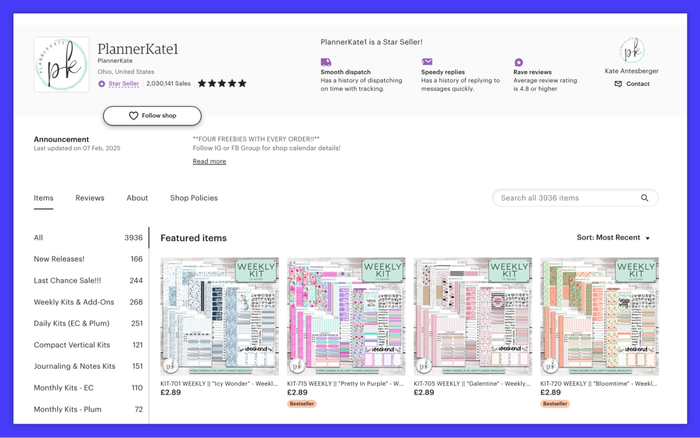
If you're thinking about scaling, start by setting goals that fit your lifestyle. Maybe you want to outsource packing orders, introduce digital downloads, or build an online course. Or maybe you’d rather keep your own small business just that — your own — and focus on steady income from a small but loyal customer base.
And if you’re still figuring it out? That’s okay too. What matters is staying open to what’s working, tracking what you can improve, and adapting when the time feels right. You don’t need to have it all figured out to move forward.
Growth doesn’t have to mean bigger. It can mean simpler, smoother, or more fulfilling. It’s your business — it should grow on your terms.
Step 11: Launch your business
You’ve done the planning and checked the boxes. Now comes the moment that turns your idea into reality: launching.
It doesn’t have to be loud or expensive. Launching your home-based business simply means opening the digital door and letting people know you're ready. For some, that might be publishing a website. For others, it’s shipping the first Etsy order, sending the first invoice, or posting on Instagram: 'I’m now taking clients!'
Whatever your business type, here’s a quick checklist to make sure you’re launch-ready:
- Your product or service is clear (what you offer, and for who)
- You have a way to get paid (bank transfer, payment link, or ecommerce platform)
- You’re reachable (email, DMs, contact form — something you’ll check)
- You’ve told someone—or better yet, a few people—that you’re live
The truth is, you’ll always feel like you could do more. Tweak the site. Rewrite your bio. Delay one more week. But your first sale or client won’t happen until you show up!
Your first customer might be a neighbor, a friend, or someone random who found you through a Facebook group. It doesn’t matter. That first 'yes' is the beginning of something real.
Peg and Awl is a great example of sustainable scaling. Margaux and Walter Kent started in their Philadelphia home, repurposing old materials into bags, journals, and home goods. Over time, they expanded their product line and team, without abandoning their core values or handmade ethos.

Their growth wasn’t overnight or VC-funded. It came from consistency, community, and sticking to what made their products special.
Step 12: Stay on track after launch
Running your own business from home means wearing every hat, and that includes staying compliant with legal, financial, and reporting requirements. It doesn’t have to be overwhelming — just build small habits that help you stay in control.
Here’s a simple cadence to follow after launch:
📆 Weekly
- Examine your cash flow: what came in, what went out, and what’s on the horizon
- Review outstanding tasks or client messages
- Check in with your schedule and energy — is the pace sustainable?
📆 Monthly
- Send invoices and follow up on payments
- Review how customers found you (what’s working?)
- Set or reset one marketing goal — even something small
📆 Quarterly
- Set aside time to file estimated taxes
- Revisit your goals — are you growing, maintaining, or adjusting?
- Review any license or permit requirements (especially if your service area has changed)
- If you’ve registered your business formally, set a reminder to review your paperwork each quarter — it’s easier to stay compliant than to catch up later.
As your customer base grows, so will your workload. Consider using tools like Capsule CRM to track relationships, follow-ups, and deal stages in one place, saving you hours and missed opportunities.
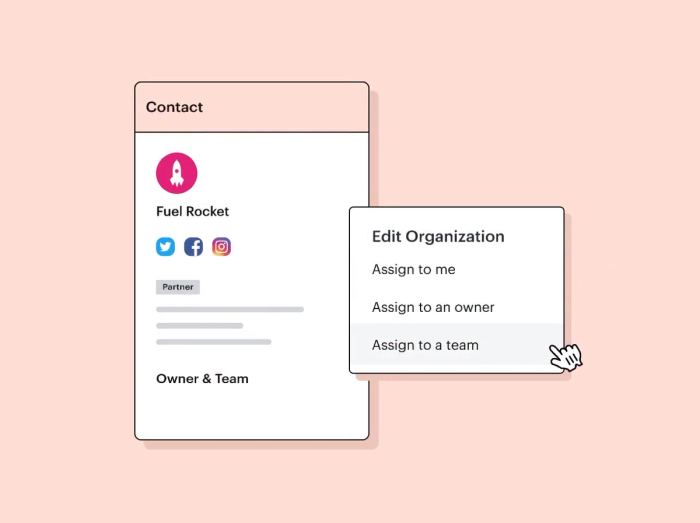
Conclusion: You're already closer than you think
You’ve done more than dream — you’ve mapped it out.
Now, turn that plan into progress. A home business starts with one offer, one post, and one invoice. And that’s enough.
No matter if your goal is a steady side income, full-time freedom, or just testing the waters, you have what you need to begin. You’ve got a room (or corner) to work from, skills worth sharing, and a step-by-step path to follow.
You’re not on your own, either. We've gathered some tools and templates to help you keep moving:
- Simple action plan template →
- Social strategy guide for solo founders →
- Growth roadmap for small businesses →
- Low-budget marketing ideas →
FAQ
The easiest small business to start at home is one that requires minimal capital investment, simple tools, and no physical storefront. Many business owners apply this to online businesses like freelance writing, offering tutoring services, or starting a dropshipping business. These models don’t require much beyond a laptop and a reliable internet connection, making them ideal for first-time entrepreneurs.
Start by choosing a home-compatible business idea and follow a clear step-by-step guide. You'll need to register a business entity, open a business checking account, and apply for a federal tax number if needed. From there, build your online presence, set up basic operations, and create a simple marketing strategy to attract your target customers. Keeping your business checklist close will help you stay on track!
You can start a wide range of businesses from home — from launching an online store or a service-based business to managing a photography business or offering legal services. The key is to choose a business structure that suits your needs and confirm that your space supports it. Many business structures require little more than a quiet room, a computer, and a clear management structure to get going.
Service-based businesses tend to be the most successful home-based ventures because of low startup costs and high demand. This includes tutoring, consulting, and digital services. Online businesses with clear marketing strategies and strong search engine optimization (SEO) also grow quickly — especially when they serve specific target customers.
With $500, you can start strong — design printables, tutor online, or even launch a dropshipping business. A low-cost setup plus free marketing tools can go a long way when paired with a focused offer.
Yes, and you’re not alone. From remote coaches to side-hustle online stores, millions use their homes as HQ — just make sure your business type fits local regulations and your living space!
For service-based businesses? Definitely. You can cover a website, register a business account, and still have budget left for marketing tools. The trick is starting lean and scaling with your first wins.
If you have skills and Wi-Fi, you’re halfway there. Many founders begin with zero capital by offering services like writing, admin help, or coaching, and reinvest their early earnings into growth!
Look to what you already know. Freelance design, landscaping business consulting, social media management, or consulting often require zero inventory and minimal startup costs — just time, consistency, and a few tools.
Listen first. Scroll local Facebook groups, check job boards, or ask friends what they'd gladly pay someone else to do. Your next business idea might already be in your inbox.
One that plays to your strengths and meets a real need. From remote-friendly services to niche ecommerce stores, success in 2025 favors flexibility, focus, and smart marketing, not flashy launches.
It’s building something big on your own terms. Small entrepreneurs often wear all the hats — from marketing to operations — while growing sustainable, independent businesses, often from home.
Most fail from avoidable gaps — no demand, inconsistent planning, or mismanaged finances. A strong business checklist and clear marketing strategy can keep you in the successful 10%.
Highly specialized service providers — legal services, SEO consultants, and niche educators — tend to top the list. Many start small and scale fast by building around value, not volume.




